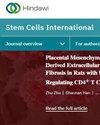CRISPR/Cas9 Genome Editing in LGMD2A/R1 Patient-Derived Induced Pluripotent Stem and Skeletal Muscle Progenitor Cells
IF 3.8
3区 医学
Q2 CELL & TISSUE ENGINEERING
引用次数: 0
Abstract
Large numbers of Calpain 3 (CAPN3) mutations cause recessive forms of limb-girdle muscular dystrophy (LGMD2A/LGMDR1) with selective atrophy of the proximal limb muscles. We have generated induced pluripotent stem cells (iPSC) from a patient with two mutations in exon 3 and exon 4 at the calpain 3 locus (W130C, 550delA). Two different strategies to rescue these mutations are devised: (i) on the level of LGMD2A-iPSC, we combined CRISPR/Cas9 genome targeting with a FACS and Tet transactivator-based biallelic selection strategy, which resulted in a new functional chimeric exon 3-4 without the two CAPN3 mutations. (ii) On the level of LGMD2A-iPSC-derived CD82+/Pax7+ myogenic progenitor cells, we demonstrate CRISPR/Cas9 mediated rescue of the highly prevalent exon 4 CAPN3 mutation. The first strategy specifically provides isogenic LGMD2A corrected iPSC for disease modelling, and the second strategy can be further elaborated for potential translational approaches.CRISPR/Cas9基因组编辑在LGMD2A/R1患者来源的诱导多能干细胞和骨骼肌祖细胞中的应用
大量的Calpain 3 (CAPN3)突变导致隐性的肢带性肌营养不良(LGMD2A/LGMDR1),伴有近端肢体肌肉的选择性萎缩。我们从一个calpain3位点(W130C, 550delA)外显子3和外显子4有两个突变的患者身上获得了诱导多能干细胞(iPSC)。设计了两种不同的策略来挽救这些突变:(i)在LGMD2A-iPSC水平上,我们将CRISPR/Cas9基因组靶向与基于FACS和Tet转录激活子的双等位基因选择策略结合起来,产生了一个新的功能嵌合外显子3-4,没有两个CAPN3突变。(ii)在lgmd2a - ipsc衍生的CD82+/Pax7+肌源性祖细胞水平上,我们证明了CRISPR/Cas9介导的高度普遍的外显子4 CAPN3突变的修复。第一种策略专门为疾病建模提供了等基因LGMD2A校正的iPSC,第二种策略可以进一步阐述潜在的翻译方法。
本文章由计算机程序翻译,如有差异,请以英文原文为准。
求助全文
约1分钟内获得全文
求助全文
来源期刊

Stem Cells International
CELL & TISSUE ENGINEERING-
CiteScore
8.10
自引率
2.30%
发文量
188
审稿时长
18 weeks
期刊介绍:
Stem Cells International is a peer-reviewed, Open Access journal that publishes original research articles, review articles, and clinical studies in all areas of stem cell biology and applications. The journal will consider basic, translational, and clinical research, including animal models and clinical trials.
Topics covered include, but are not limited to: embryonic stem cells; induced pluripotent stem cells; tissue-specific stem cells; stem cell differentiation; genetics and epigenetics; cancer stem cells; stem cell technologies; ethical, legal, and social issues.
 求助内容:
求助内容: 应助结果提醒方式:
应助结果提醒方式:


